2010 MERCEDES-BENZ R320 height
[x] Cancel search: heightPage 12 of 364

Gross Vehicle Weight
see GVW
Gross Vehicle Weight Rating
see GVWR
GTW (Gross Trailer Weight) ..............249
GVW (Gross Vehicle Weight) ............249
GVWR (Gross Vehicle Weight
Rating) ................................................ 249H
Halogen headlamps see Headlamps
Hard plastic trim items, cleaning ....267
Hazard warning flasher ....................101
Headlamp cleaning system .............. 101
Headlamps
Active Bi-Xenon headlamps ............. 97
Automatic headlamp mode .............. 98
Bi-Xenon .................................. 97, 313
Cleaning lenses ............................. 265
Cleaning system ............................ 101
Daytime running lamp mode ............99
Delayed shut-off ............................ 135
Halogen ......................................... 313
High-beam flasher .........................101
High-beam headlamps ...................100
Low-beam headlamps ...................... 98
Replacing bulbs ............................. 312
Switch .............................................. 97
Headliner, cleaning and care of .......267
Head restraints .................................... 81
Adjustment ................................ 81, 83
NECK-PRO active front head
restraints ......................................... 53
NECK-PRO active front head
restraints, resetting ....................... 310
Heated steering wheel ........................93
Height adjustment
Seat belt outlet ................................ 50
Seats ............................................... 81
Vehicle level control ...................... 154
High-beam flasher ............................. 101
High-beam headlamps ..............100, 313
Indicator lamp .................................. 29
Hill-start assist system ..................... 153
Hinged quarter windows .................. 107Hood ...................................................
222
Messages in the multifunction
display
........................................... 288
Hooks ................................................. 189
Horn ...................................................... 27
HVAC see Climate control system
Hydroplaning ..................................... 255 I
Identification labels ..........................344
Identification number, vehicle
(VIN) ................................................... 345
Ignition ................................... 79, 80, 111
Immobilizer .......................................... 67
Indicator lamps see Lamps, indicator and warning
Infant and child restraint systems
see Children in the vehicle
Inflation pressure
see Tires, Inflation pressure
Infrared reflecting windshield .........217
Inside door handle .............................. 74
Instrument cluster ......................28, 122
Illumination .................................... 123
Lamps ............................................ 299
Multifunction display .....................125
Instrument lighting
see Instrument cluster, Illumination
Instrument panel
see Instrument cluster
Instruments and controls
see Cockpit
Interior lighting
Delayed shut-off ............................ 136
Emergency lighting ........................ 103
Front .............................................. 102
Front reading lamps ....................... 102
Rear ............................................... 103
Rear reading lamps ........................ 103
Interior rear view mirror .....................94
Auto-dimming rear view mirrors ....... 94
Interior storage spaces
see Storage compartments
Intermittent wiping
Rain sensor .................................... 10410
Index 251_AKB; 4; 52, en-US
d2ureepe,
Version: 2.11.8.1 2009-03-23T09:22:52+01:00 - Seite 10
Page 17 of 364
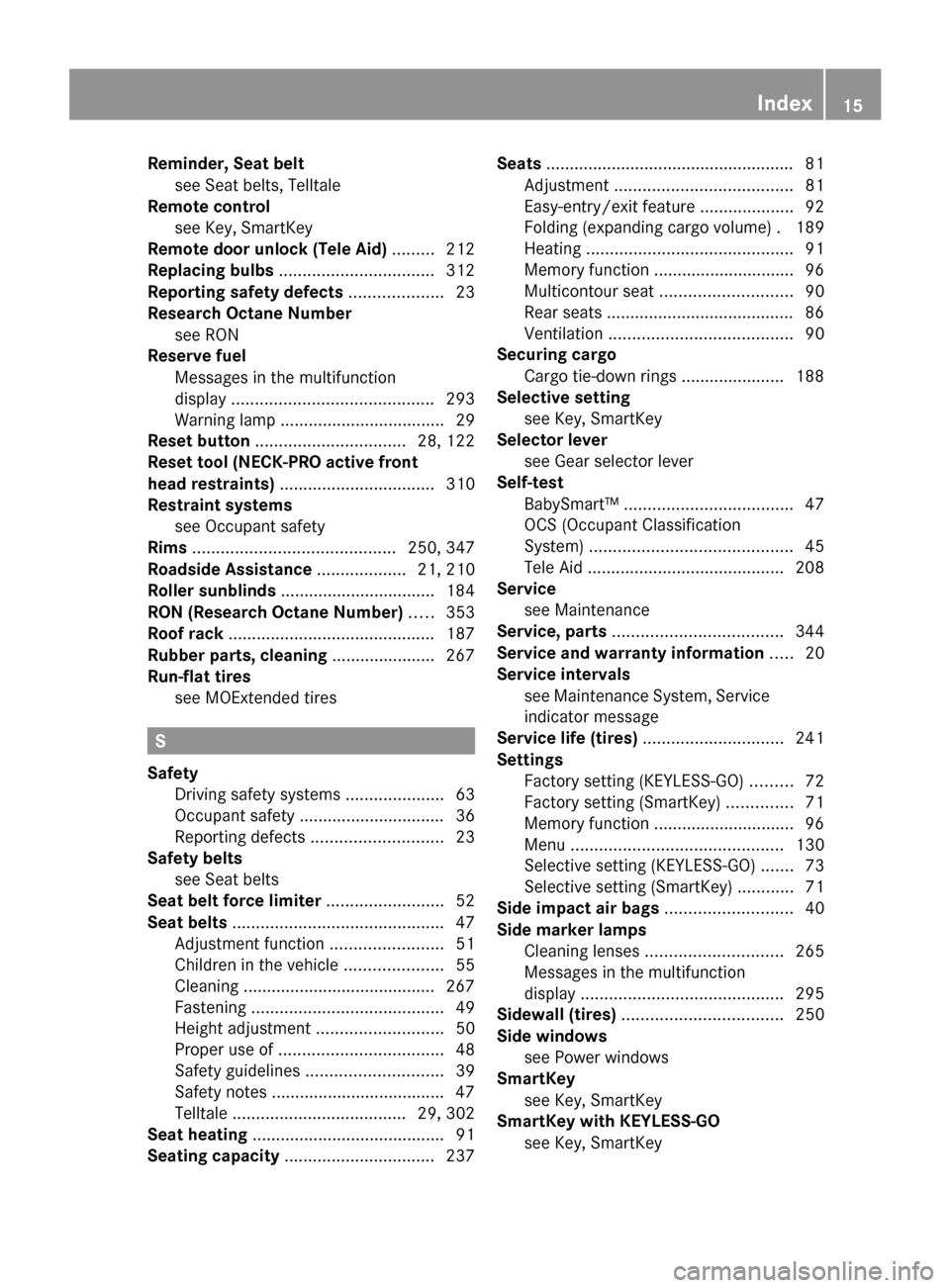
Reminder, Seat belt
see Seat belts, Telltale
Remote control
see Key, SmartKey
Remote door unlock (Tele Aid) .........212
Replacing bulbs ................................. 312
Reporting safety defects .................... 23
Research Octane Number see RON
Reserve fuel
Messages in the multifunction
display ........................................... 293
Warning lamp ................................... 29
Reset button ................................ 28, 122
Reset tool (NECK-PRO active front
head restraints) ................................. 310
Restraint systems see Occupant safety
Rims ........................................... 250, 347
Roadside Assistance ...................21, 210
Roller sunblinds ................................. 184
RON (Research Octane Number) ..... 353
Roof rack ............................................ 187
Rubber parts, cleaning ...................... 267
Run-flat tires see MOExtended tires S
Safety Driving safety systems ..................... 63
Occupant safety ...............................
36
Reporting defects ............................ 23
Safety belts
see Seat belts
Seat belt force limiter ......................... 52
Seat belts ............................................. 47
Adjustment function ........................51
Children in the vehicle .....................55
Cleaning ......................................... 267
Fastening ......................................... 49
Height adjustment ...........................50
Proper use of ................................... 48
Safety guidelines ............................. 39
Safety notes ..................................... 47
Telltale ..................................... 29, 302
Seat heating ......................................... 91
Seating capacity ................................ 237Seats .....................................................
81
Adjustment ...................................... 81
Easy-entry/exit feature ....................92
Folding (expanding cargo volume) . 189
Heating ............................................ 91
Memory function .............................. 96
Multicontour seat ............................ 90
Rear seats ........................................ 86
Ventilation ....................................... 90
Securing cargo
Cargo tie-down rings ...................... 188
Selective setting
see Key, SmartKey
Selector lever
see Gear selector lever
Self-test
BabySmart™ .................................... 47
OCS (Occupant Classification
System) ........................................... 45
Tele Aid .......................................... 208
Service
see Maintenance
Service, parts .................................... 344
Service and warranty information .....20
Service intervals see Maintenance System, Service
indicator message
Service life (tires) .............................. 241
Settings Factory setting (KEYLESS-GO) ......... 72
Factory setting (SmartKey) ..............71
Memory function .............................. 96
Menu ............................................. 130
Selective setting (KEYLESS-GO) ....... 73
Selective setting (SmartKey) ............71
Side impact air bags ...........................40
Side marker lamps
Cleaning lenses ............................. 265
Messages in the multifunction
display ........................................... 295
Sidewall (tires) .................................. 250
Side windows see Power windows
SmartKey
see Key, SmartKey
SmartKey with KEYLESS-GO
see Key, SmartKey Index
15 251_AKB; 4; 52, en-US
d2ureepe,
Version: 2.11.8.1 2009-03-23T09:22:52+01:00 - Seite 15
Page 51 of 364
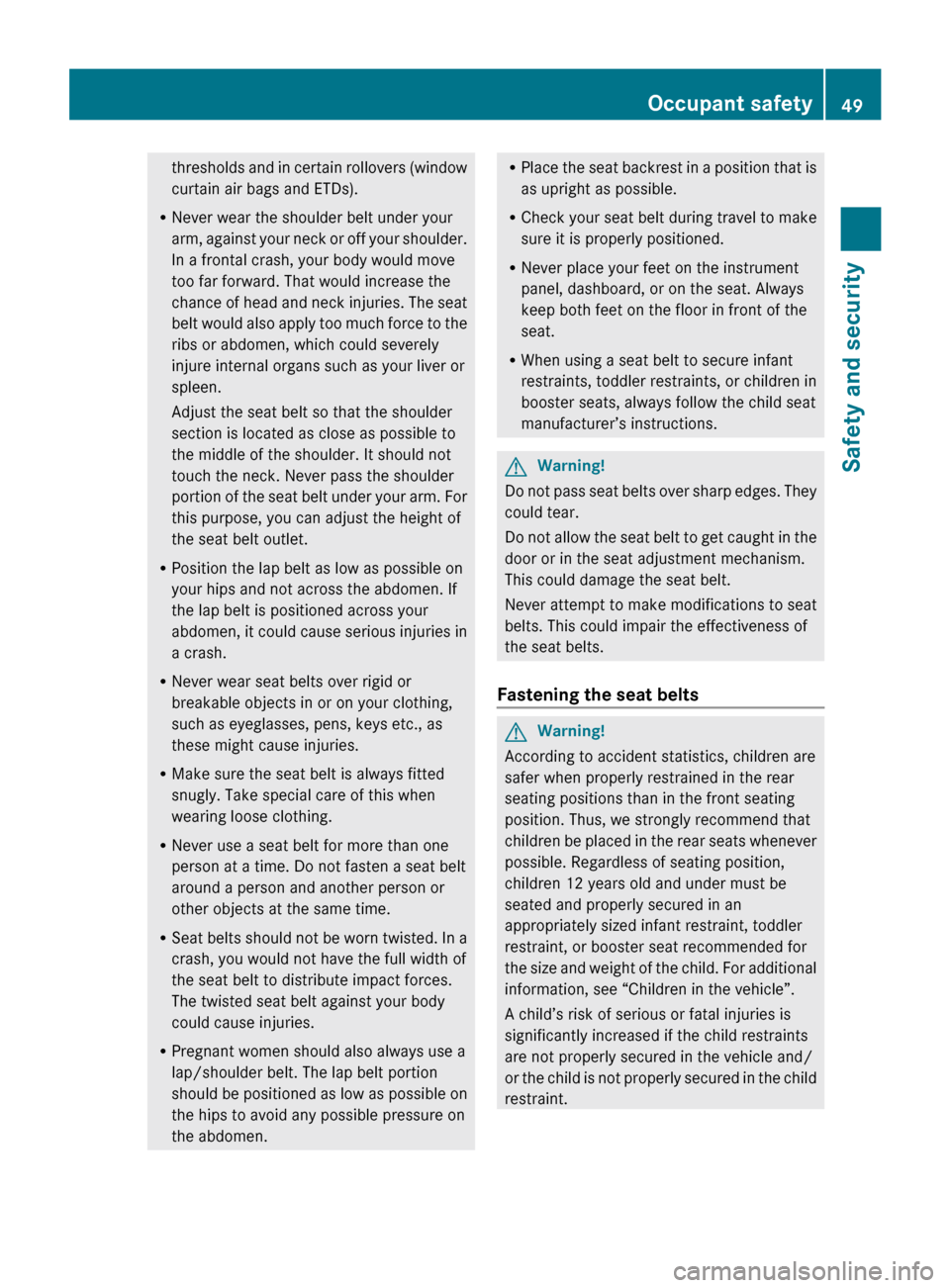
thresholds and in certain rollovers (window
curtain air bags and ETDs).
R Never wear the shoulder belt under your
arm,
against your neck or off your shoulder.
In a frontal crash, your body would move
too far forward. That would increase the
chance of head and neck injuries. The seat
belt would also apply too much force to the
ribs or abdomen, which could severely
injure internal organs such as your liver or
spleen.
Adjust the seat belt so that the shoulder
section is located as close as possible to
the middle of the shoulder. It should not
touch the neck. Never pass the shoulder
portion of the seat belt under your arm. For
this purpose, you can adjust the height of
the seat belt outlet.
R Position the lap belt as low as possible on
your hips and not across the abdomen. If
the lap belt is positioned across your
abdomen, it could cause serious injuries in
a crash.
R Never wear seat belts over rigid or
breakable objects in or on your clothing,
such as eyeglasses, pens, keys etc., as
these might cause injuries.
R Make sure the seat belt is always fitted
snugly. Take special care of this when
wearing loose clothing.
R Never use a seat belt for more than one
person at a time. Do not fasten a seat belt
around a person and another person or
other objects at the same time.
R Seat belts should not be worn twisted. In a
crash, you would not have the full width of
the seat belt to distribute impact forces.
The twisted seat belt against your body
could cause injuries.
R Pregnant women should also always use a
lap/shoulder belt. The lap belt portion
should be positioned as low as possible on
the hips to avoid any possible pressure on
the abdomen. R
Place the seat backrest in a position that is
as upright as possible.
R Check your seat belt during travel to make
sure it is properly positioned.
R Never place your feet on the instrument
panel, dashboard, or on the seat. Always
keep both feet on the floor in front of the
seat.
R When using a seat belt to secure infant
restraints, toddler restraints, or children in
booster seats, always follow the child seat
manufacturer’s instructions. G
Warning!
Do not pass seat belts over sharp edges. They
could tear.
Do
not allow the seat belt to get caught in the
door or in the seat adjustment mechanism.
This could damage the seat belt.
Never attempt to make modifications to seat
belts. This could impair the effectiveness of
the seat belts.
Fastening the seat belts G
Warning!
According to accident statistics, children are
safer when properly restrained in the rear
seating positions than in the front seating
position. Thus, we strongly recommend that
children
be placed in the rear seats whenever
possible. Regardless of seating position,
children 12 years old and under must be
seated and properly secured in an
appropriately sized infant restraint, toddler
restraint, or booster seat recommended for
the size and weight of the child. For additional
information, see “Children in the vehicle”.
A child’s risk of serious or fatal injuries is
significantly increased if the child restraints
are not properly secured in the vehicle and/
or the child is not properly secured in the child
restraint. Occupant safety
49
Safety and security
251_AKB; 4; 52, en-US
d2ureepe, Version: 2.11.8.1 2009-03-23T09:22:52+01:00 - Seite 49 Z
Page 52 of 364
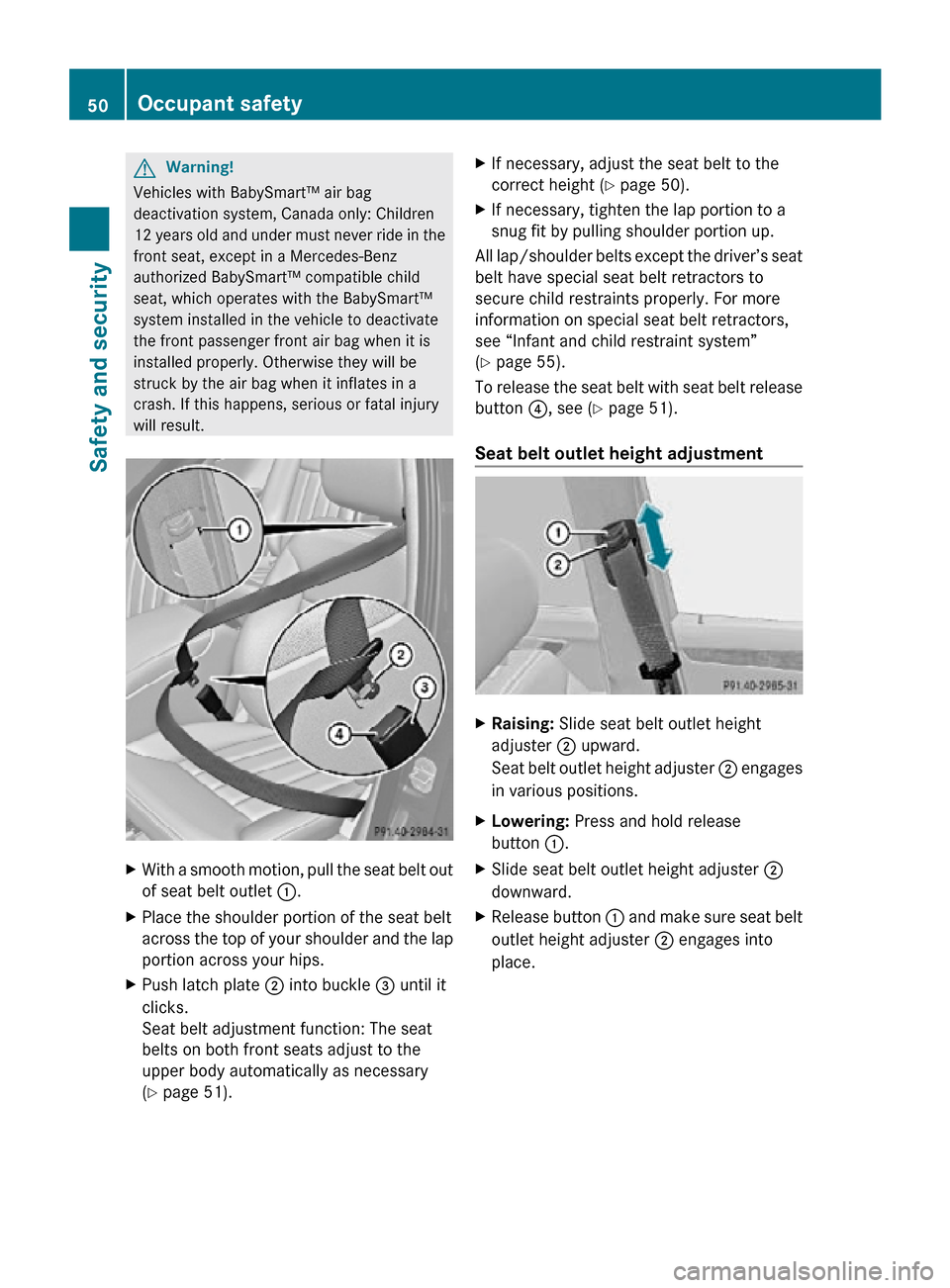
G
Warning!
Vehicles with BabySmart™ air bag
deactivation system, Canada only: Children
12 years old and under must never ride in the
front seat, except in a Mercedes-Benz
authorized BabySmart™ compatible child
seat, which operates with the BabySmart™
system installed in the vehicle to deactivate
the front passenger front air bag when it is
installed properly. Otherwise they will be
struck by the air bag when it inflates in a
crash. If this happens, serious or fatal injury
will result. X
With a smooth motion, pull the seat belt out
of seat belt outlet :.
X Place the shoulder portion of the seat belt
across the top of your shoulder and the lap
portion across your hips.
X Push latch plate ; into buckle = until it
clicks.
Seat belt adjustment function: The seat
belts on both front seats adjust to the
upper body automatically as necessary
(Y page 51). X
If necessary, adjust the seat belt to the
correct height (Y page 50).
X If necessary, tighten the lap portion to a
snug fit by pulling shoulder portion up.
All lap/shoulder belts except the driver’s seat
belt have special seat belt retractors to
secure child restraints properly. For more
information on special seat belt retractors,
see “Infant and child restraint system”
(Y page 55).
To release the seat belt with seat belt release
button ?, see ( Y page 51).
Seat belt outlet height adjustment X
Raising: Slide seat belt outlet height
adjuster ; upward.
Seat belt outlet height adjuster ; engages
in various positions.
X Lowering: Press and hold release
button :.
X Slide seat belt outlet height adjuster ;
downward.
X Release button : and make sure seat belt
outlet height adjuster ; engages into
place. 50
Occupant safetySafety and security
251_AKB; 4; 52, en-US
d2ureepe,
Version: 2.11.8.1 2009-03-23T09:22:52+01:00 - Seite 50
Page 55 of 364
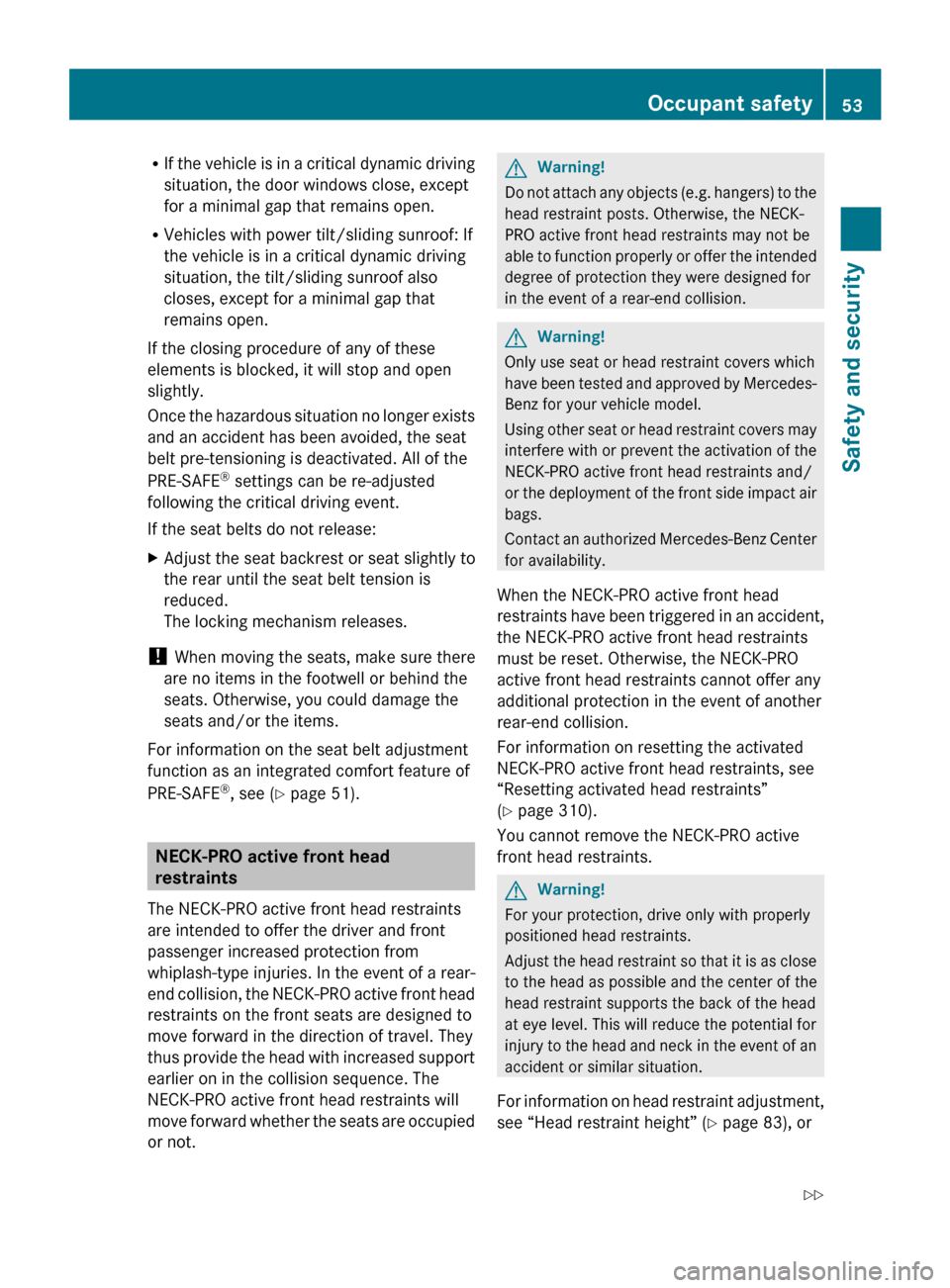
R
If the vehicle is in a critical dynamic driving
situation, the door windows close, except
for a minimal gap that remains open.
R Vehicles with power tilt/sliding sunroof: If
the vehicle is in a critical dynamic driving
situation, the tilt/sliding sunroof also
closes, except for a minimal gap that
remains open.
If the closing procedure of any of these
elements is blocked, it will stop and open
slightly.
Once the hazardous situation no longer exists
and an accident has been avoided, the seat
belt pre-tensioning is deactivated. All of the
PRE-SAFE ®
settings can be re-adjusted
following the critical driving event.
If the seat belts do not release:
X Adjust the seat backrest or seat slightly to
the rear until the seat belt tension is
reduced.
The locking mechanism releases.
! When moving the seats, make sure there
are no items in the footwell or behind the
seats. Otherwise, you could damage the
seats and/or the items.
For information on the seat belt adjustment
function as an integrated comfort feature of
PRE-SAFE ®
, see ( Y page 51). NECK-PRO active front head
restraints
The NECK-PRO active front head restraints
are intended to offer the driver and front
passenger increased protection from
whiplash-type injuries. In the event of a rear-
end
collision, the NECK-PRO active front head
restraints on the front seats are designed to
move forward in the direction of travel. They
thus provide the head with increased support
earlier on in the collision sequence. The
NECK-PRO active front head restraints will
move forward whether the seats are occupied
or not. G
Warning!
Do not attach any objects (e.g. hangers) to the
head restraint posts. Otherwise, the NECK-
PRO active front head restraints may not be
able
to function properly or offer the intended
degree of protection they were designed for
in the event of a rear-end collision. G
Warning!
Only use seat or head restraint covers which
have
been tested and approved by Mercedes-
Benz for your vehicle model.
Using other seat or head restraint covers may
interfere with or prevent the activation of the
NECK-PRO active front head restraints and/
or the deployment of the front side impact air
bags.
Contact an authorized Mercedes-Benz Center
for availability.
When the NECK-PRO active front head
restraints have been triggered in an accident,
the NECK-PRO active front head restraints
must be reset. Otherwise, the NECK-PRO
active front head restraints cannot offer any
additional protection in the event of another
rear-end collision.
For information on resetting the activated
NECK-PRO active front head restraints, see
“Resetting activated head restraints”
(Y page 310).
You cannot remove the NECK-PRO active
front head restraints. G
Warning!
For your protection, drive only with properly
positioned head restraints.
Adjust
the head restraint so that it is as close
to the head as possible and the center of the
head restraint supports the back of the head
at eye level. This will reduce the potential for
injury to the head and neck in the event of an
accident or similar situation.
For information on head restraint adjustment,
see “Head restraint height” ( Y page 83), or Occupant safety
53
Safety and security
251_AKB; 4; 52, en-US
d2ureepe, Version: 2.11.8.1 2009-03-23T09:22:52+01:00 - Seite 53 Z
Page 59 of 364
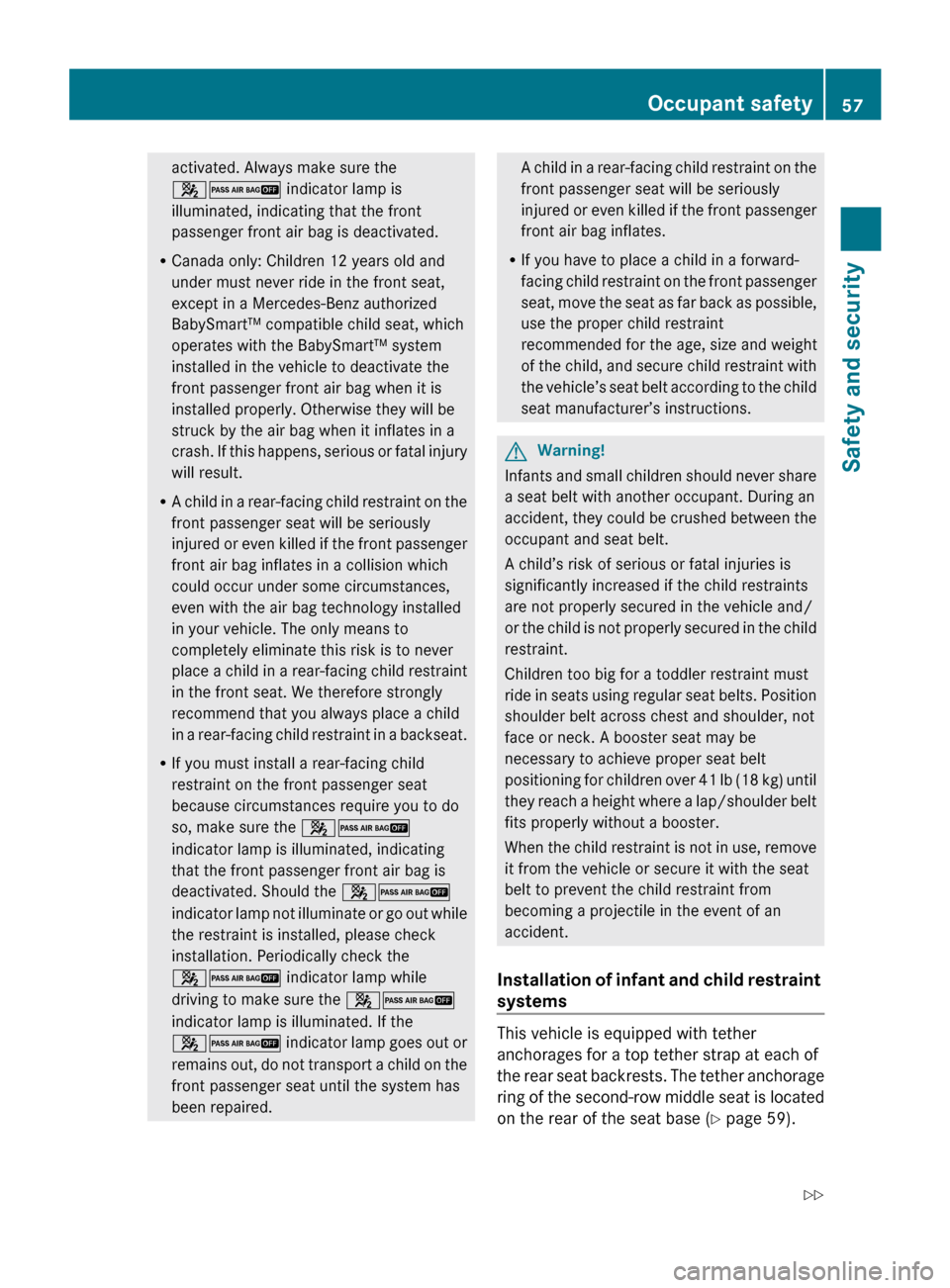
activated. Always make sure the
42 indicator lamp is
illuminated, indicating that the front
passenger front air bag is deactivated.
R Canada only: Children 12 years old and
under must never ride in the front seat,
except in a Mercedes-Benz authorized
BabySmart™ compatible child seat, which
operates with the BabySmart™ system
installed in the vehicle to deactivate the
front passenger front air bag when it is
installed properly. Otherwise they will be
struck by the air bag when it inflates in a
crash.
If this happens, serious or fatal injury
will result.
R A child in a rear-facing child restraint on the
front passenger seat will be seriously
injured or even killed if the front passenger
front air bag inflates in a collision which
could occur under some circumstances,
even with the air bag technology installed
in your vehicle. The only means to
completely eliminate this risk is to never
place a child in a rear-facing child restraint
in the front seat. We therefore strongly
recommend that you always place a child
in a rear-facing child restraint in a backseat.
R If you must install a rear-facing child
restraint on the front passenger seat
because circumstances require you to do
so, make sure the 42
indicator lamp is illuminated, indicating
that the front passenger front air bag is
deactivated. Should the 42
indicator lamp not illuminate or go out while
the restraint is installed, please check
installation. Periodically check the
42 indicator lamp while
driving to make sure the 42
indicator lamp is illuminated. If the
42 indicator lamp goes out or
remains out, do not transport a child on the
front passenger seat until the system has
been repaired. A child in a rear-facing child restraint on the
front passenger seat will be seriously
injured
or even killed if the front passenger
front air bag inflates.
R If you have to place a child in a forward-
facing child restraint on the front passenger
seat, move the seat as far back as possible,
use the proper child restraint
recommended for the age, size and weight
of the child, and secure child restraint with
the vehicle’s seat belt according to the child
seat manufacturer’s instructions. G
Warning!
Infants and small children should never share
a seat belt with another occupant. During an
accident,
they could be crushed between the
occupant and seat belt.
A child’s risk of serious or fatal injuries is
significantly increased if the child restraints
are not properly secured in the vehicle and/
or the child is not properly secured in the child
restraint.
Children too big for a toddler restraint must
ride in seats using regular seat belts. Position
shoulder belt across chest and shoulder, not
face or neck. A booster seat may be
necessary to achieve proper seat belt
positioning for children over 41 lb (18 kg) until
they reach a height where a lap/shoulder belt
fits properly without a booster.
When the child restraint is not in use, remove
it from the vehicle or secure it with the seat
belt to prevent the child restraint from
becoming a projectile in the event of an
accident.
Installation of infant and child restraint
systems This vehicle is equipped with tether
anchorages for a top tether strap at each of
the
rear seat backrests. The tether anchorage
ring of the second-row middle seat is located
on the rear of the seat base ( Y page 59). Occupant safety
57
Safety and security
251_AKB; 4; 52, en-US
d2ureepe, Version: 2.11.8.1 2009-03-23T09:22:52+01:00 - Seite 57 Z
Page 62 of 364
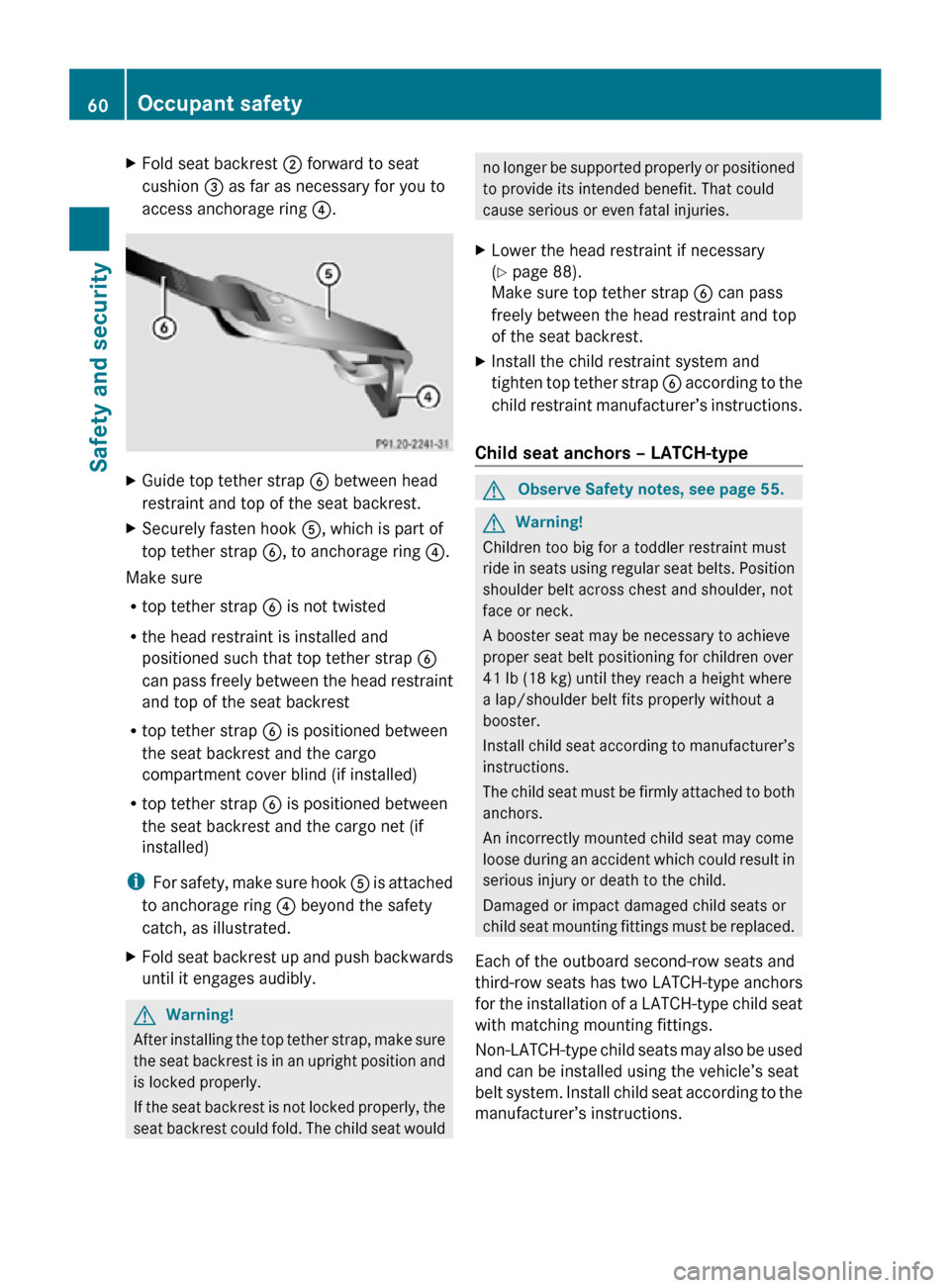
X
Fold seat backrest ; forward to seat
cushion = as far as necessary for you to
access anchorage ring ?. X
Guide top tether strap B between head
restraint and top of the seat backrest.
X Securely fasten hook A, which is part of
top tether strap B, to anchorage ring ?.
Make sure
R top tether strap B is not twisted
R the head restraint is installed and
positioned such that top tether strap B
can pass freely between the head restraint
and top of the seat backrest
R top tether strap B is positioned between
the seat backrest and the cargo
compartment cover blind (if installed)
R top tether strap B is positioned between
the seat backrest and the cargo net (if
installed)
i For safety, make sure hook A is attached
to anchorage ring ? beyond the safety
catch, as illustrated.
X Fold seat backrest up and push backwards
until it engages audibly. G
Warning!
After installing the top tether strap, make sure
the seat backrest is in an upright position and
is locked properly.
If the seat backrest is not locked properly, the
seat backrest could fold. The child seat would no longer be supported properly or positioned
to provide its intended benefit. That could
cause serious or even fatal injuries.
X Lower the head restraint if necessary
(Y page 88).
Make sure top tether strap B can pass
freely between the head restraint and top
of the seat backrest.
X Install the child restraint system and
tighten top tether strap B according to the
child restraint manufacturer’s instructions.
Child seat anchors – LATCH-type G
Observe Safety notes, see page 55. G
Warning!
Children too big for a toddler restraint must
ride in seats using regular seat belts. Position
shoulder belt across chest and shoulder, not
face or neck.
A booster seat may be necessary to achieve
proper seat belt positioning for children over
41 lb (18 kg) until they reach a height where
a lap/shoulder belt fits properly without a
booster.
Install child seat according to manufacturer’s
instructions.
The child seat must be firmly attached to both
anchors.
An incorrectly mounted child seat may come
loose during an accident which could result in
serious injury or death to the child.
Damaged or impact damaged child seats or
child seat mounting fittings must be replaced.
Each of the outboard second-row seats and
third-row seats has two LATCH-type anchors
for the installation of a LATCH-type child seat
with matching mounting fittings.
Non-LATCH-type child seats may also be used
and can be installed using the vehicle’s seat
belt system. Install child seat according to the
manufacturer’s instructions. 60
Occupant safetySafety and security
251_AKB; 4; 52, en-US
d2ureepe,
Version: 2.11.8.1 2009-03-23T09:22:52+01:00 - Seite 60
Page 77 of 364
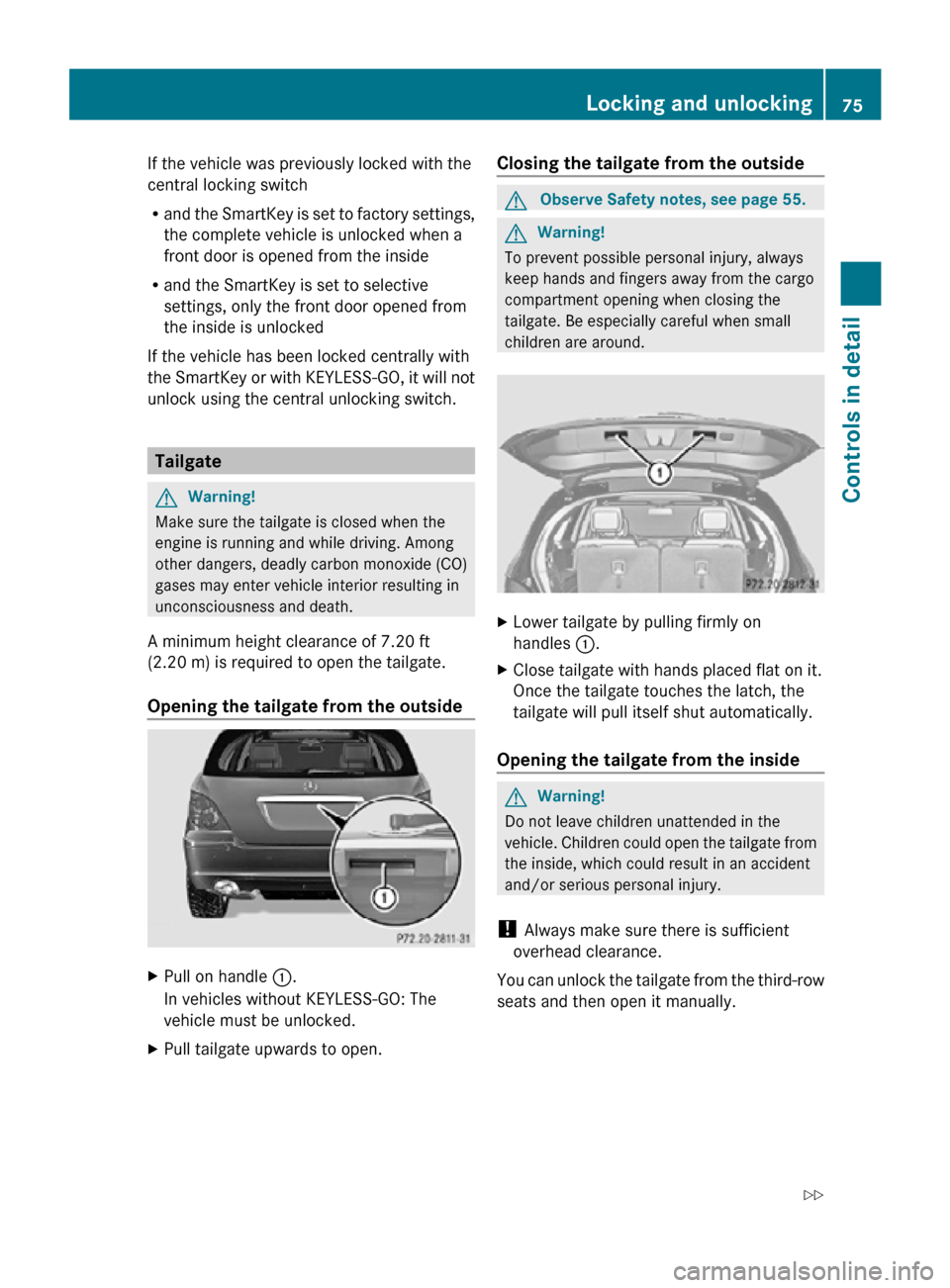
If the vehicle was previously locked with the
central locking switch
R
and the SmartKey is set to factory settings,
the complete vehicle is unlocked when a
front door is opened from the inside
R and the SmartKey is set to selective
settings, only the front door opened from
the inside is unlocked
If the vehicle has been locked centrally with
the SmartKey or with KEYLESS-GO, it will not
unlock using the central unlocking switch. Tailgate
G
Warning!
Make sure the tailgate is closed when the
engine is running and while driving. Among
other dangers, deadly carbon monoxide (CO)
gases may enter vehicle interior resulting in
unconsciousness and death.
A minimum height clearance of 7.20 ft
(2.20 m) is required to open the tailgate.
Opening the tailgate from the outside X
Pull on handle :.
In vehicles without KEYLESS-GO: The
vehicle must be unlocked.
X Pull tailgate upwards to open. Closing the tailgate from the outside G
Observe Safety notes, see page 55. G
Warning!
To prevent possible personal injury, always
keep hands and fingers away from the cargo
compartment opening when closing the
tailgate. Be especially careful when small
children are around. X
Lower tailgate by pulling firmly on
handles :.
X Close tailgate with hands placed flat on it.
Once the tailgate touches the latch, the
tailgate will pull itself shut automatically.
Opening the tailgate from the inside G
Warning!
Do not leave children unattended in the
vehicle. Children could open the tailgate from
the inside, which could result in an accident
and/or serious personal injury.
! Always make sure there is sufficient
overhead clearance.
You can unlock the tailgate from the third-row
seats and then open it manually. Locking and unlocking
75Controls in detail
251_AKB; 4; 52, en-US
d2ureepe, Version: 2.11.8.1 2009-03-23T09:22:52+01:00 - Seite 75 Z